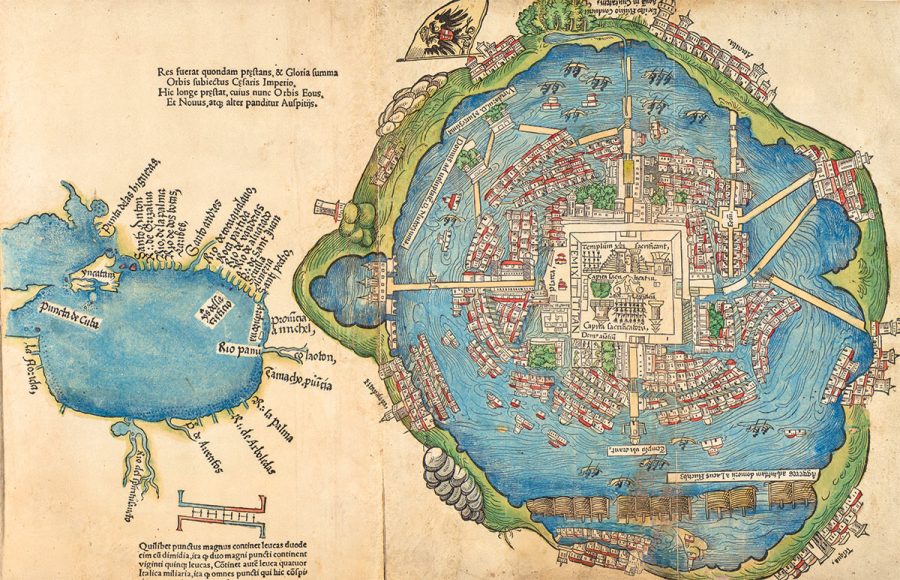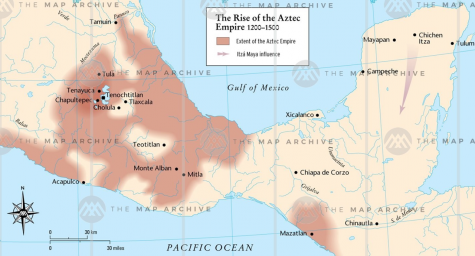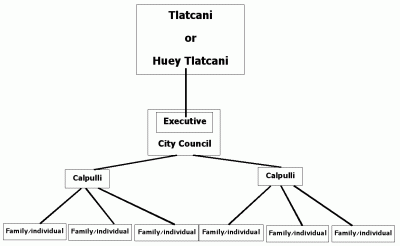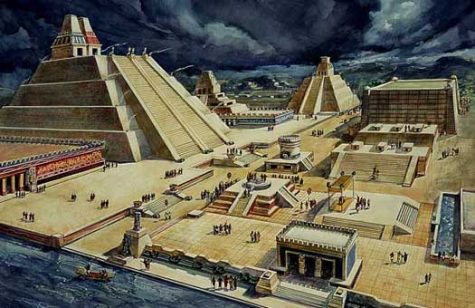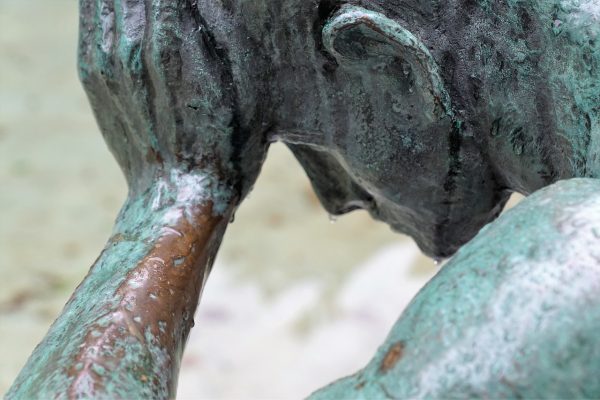Aztecs: The Ones Who Worshiped the Sun
Ancient Civilizations have been the fascination of many historians throughout the years. From Mesopotamia, to India, to Tibet, all the way to Rome and Egypt. But there is one civilization that some deem to be un-intriguing, or uninteresting. The Aztecs. The Aztecs were a civilization of once nomadic people that ended up settling down in modern day Mexico. They were a great Empire that lasted from the 14th-16th centuries, or more specifically somewhere from around the years 1300-1521. Their culture is one of the world’s most alluring in all of history. From different art, language, traditions, and religion, the Aztec Empire was one of the most prosperous in the Western Hemisphere.
Map of the Empire
The Aztec Empire was that of a colossus scale, and almost rivaled the size of the countries in Europe at the time. It was located right in the middle of modern-day Mexico. Spanning from today’s Mexico City to the Chiapas (region in south Mexico). The empire consisted of many provinces and cities. Most of them were located near Lake Texcoco including their capital Tenochtitlan which was on an island in the middle of the lake. The city would later evolve into Mexico City and grew to 10 times the size. After the Spanish take-over, and their attempts to prevent flooding, the lake was mostly dried out. On this dried-out lake they built onto the already existing Tenochtitlan, creating Mexico City.
The Government
The Aztec Empire was controlled primarily by a political body called the Triple Alliance, made up of the Acolhua people of Texcoco, the Mexica in Tenochtitlan, and the Tepaneca people of Tlacopan (all the people living around Lake Texcoco). The Triple alliance was 2nd to the top of the government and served as the high council. The basic unit of ancient Aztec government was the Calpulli. Families in the Empire didn’t individually own land, the land was owned by a group of families, the Calpulli. This structure of local government existed years before the Aztec Empire. The Calpulli leadership were responsible for the basic needs of the group. They set up the telpochcalli, a school for common citizens.
The Calpulli were also responsible for managing the taxes in the empire. In cities, each Calpulli would have a leader, and those leaders would form another council. It was these city councils that held a lot of power in the ancient Aztec government. But, the Aztecs still had and emperor. He was known as the Huey Tlatcani, or Great Speaker, who was worshiped as a god. His rule was supported not only by the city council, but also the priests, judges, governors, and a host of other officials. Moctezuma II was the Huey Tlatcani, who ruled during the period when the conquistador Hernan Cortes arrived in the New World. The Huey Tlatcani did have absolute power in a sense. However, he came to power by a semi-democratic system, and he could be removed from power (similarly to the Roman Senate, in which an appointed official didn’t have complete power unless they were in a time of war). How this position was decided upon is still not fully understood. It doesn’t seem to have been hereditary, but family lines did play some part.
Social Classes
There were two main social classes in Aztec culture. The nobility, or Pilli, and the common people, or Macehualli. Each of these was further broken up into groups of people that had quite different lives. The nobles had the ability to enter the leadership positions in the government. They had more wealth than the common folk, and were allowed to enjoy pieces of art. The common citizens on the other hand didn’t have much leeway room, they were stuck in the lower/middle classes and had the basic jobs. They could be anyone from a merchant and artisan to an athlete. There were also slaves, which were generally well-treated. Slavery was not hereditary, as the children of a slave were free. There were ways for a slave to gain freedom, such as purchasing it.
Language
The language spoken by the Aztecs was called Nahuatl. It originated earlier than the Aztec Empire, from as early as 600AD, languages known as Nahuan (later called Nahuatl) were spoken by peoples in the area. It is believed that these people came from the north in waves, settling in central Mexico. The people who spoke the language started to gain power, by the 1000AD its is likely they were in charge and were one of the primary forces that helped found the empire. The Nahuatl language is an agglutinative language, meaning that words and phrases are put together by combining prefixes, suffixes, and root words, to form an idea. For example, in Tetelcingo Nahuatl (a modern dialect), there is an 18-syllable word that means “you honorable people might have come along banging your noses so as to make them bleed, but in fact you didn’t.” So, in the language one can just put ideas together endlessly, which made it easier to communicate. It was a language of trade, and a language of prestige. It was also used in literature extensively.
The Calendar Stone
The calendar stone is probably one of the most famous and most recognizable artifacts in the world, almost on the level of the Rosetta Stone. The Aztecs were very religious from justifying everyday occurrences, to sacrificing themselves to please the gods. They also used religion and belief as the blueprint for this marvel of an artifact. It naturally, it was dedicated to the sun god. It was a massive carving, 3 feet thick, almost 12 feet across, and weighing almost 25 tons (22.5 tons). It was carved from basalt – a solidified lava, this being an area where volcanoes were common. But then it was lost – buried under the central square of Aztec calendar stone Mexico City – for over 300 years. Then, in 1790, renovations began on the central square (Zocalo) of Mexico City. On December 17th, the massive carving was unearthed, renewing interest in Mexico’s ancient cultures. There are 2 calendars, though both inter-relate in religion and ceremony, it’s the Tonalpohualli (the second one) that is considered the sacred calendar. Each had 20 signs and 13 numbers and had 365 days like the one we use today. But, its most interesting feature was when the 2 calendars aligned and signified the end of the world. Which was supposed to be in 2012. We all know they were wrong now, but this doesn’t change the importance and amazing construction of this calendar.
Religion
The Aztec religion is polytheistic-meaning it has many gods. Their belief was that god tried to make earth 5 times. His plans were foiled by fighting among the gods. Each one of these times another “creator-god” would take turn being the sun. These 5 were later known as the sun gods of the Aztecs. Eventually after the 5th time, they had a council and decided one of them would have to sacrifice himself to become the sun. Nanauatl-a god, became the sun, but there was a problem he wasn’t moving. The gods realized that they all must sacrifice themselves, so that the sun would move. The god Ehecatl sacrificed the others, and a mighty wind arose to move the sun at last. However, it wasn’t a free sacrifice the humans would have help keep the sun moving by way of sacrifice. This story named “Legend of the 5 Suns,” like origins of many other cultures helped shape Aztec society. Sacrificing citizens became a common practice. If one was chosen by a priest, its was a great honor. Citizens would voluntarily give their life in honor of the gods who sacrificed themselves to give them the sun as well as keep it moving.
The Fall of the Aztecs
The Aztecs, despite their sacrificing way of life, were a prosperous and powerful nation. In the 1600s after Columbus “discovered the West Indies” Spain sent conquistadors to search for gold and more slaves. One of these conquistadors was Hernando Cortes, and he is the primary reason for the fall of the Aztecs. There were multiple reasons. When Cortes arrived, the Aztecs never before seeing horses or iron, believed he was a god and let their guard down. Cortes took this to his advantage and use this, along with extremely well thought out tactics, to wipe out the Aztecs. Another was the Aztec’s lack of ability to fend off European diseases. They were never exposed to them before, and their immune system failed to fend them off, as a result they died in large numbers. Although their story is tragic, from their fall to their way of sacrifice, they were still a great and powerful empire with a long history which is worth learning. The more we learn from history the more we are able to prevent genocides, such as the one committed by Cortes and his men. They were motivated by things bad people are still motivated today, Greed and Glory.

